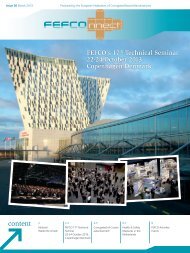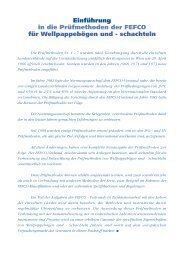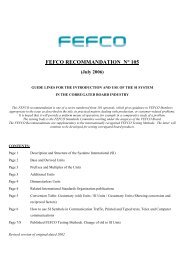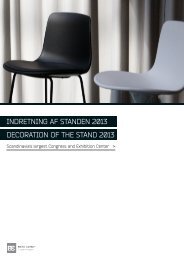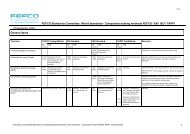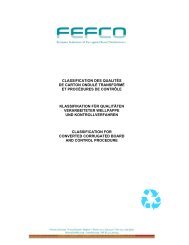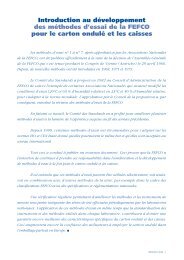Read - Fefco
Read - Fefco
Read - Fefco
You also want an ePaper? Increase the reach of your titles
YUMPU automatically turns print PDFs into web optimized ePapers that Google loves.
Avian flu exposes health<br />
risks of re-usables<br />
At the end of October the first proof was established<br />
that Avian flu had entered Europe. Since<br />
then European authorities have done everything<br />
possible to bring measures in place to<br />
prevent any further spread. Although wild birds<br />
are thought to have been responsible for bringing<br />
the disease into Europe, the transport of<br />
live poultry is one of major causes for the quick<br />
expansion of the affected area as experiences<br />
from Asia have shown.<br />
Live poultry is normally<br />
transported from the<br />
breeder to the slaughterhouse<br />
in re-usable crates or cages made of<br />
plastic or wire mesh. These crates become contaminated<br />
with excrements and feathers and<br />
so form a source for infection at the next farm<br />
they reach. The risk is enormous: only 1 gram<br />
of excrements is capable of infecting a million<br />
animals 1 .<br />
Washing of re-usable crates has been considered<br />
the answer. After all, rinsing with (warm)<br />
water and the use of detergents and/or anti-microbials<br />
was thought to be sufficient for disinfection.<br />
This is not true however. Several studies<br />
have shown that salmonella or campylobacter<br />
contaminations were not being removed. In the<br />
case of the H5N1 Avian flu virus, washing will<br />
most likely not be adequate either.<br />
According to the UK Food Standards Agency<br />
that commissioned studies into this subject,<br />
crate washing operations tend to save on<br />
heating, water, detergents and disinfectants for<br />
cost reasons, consequently making the results<br />
of washing processes very uncertain.<br />
Plastic crates have been designed to pair the<br />
lowest possible weight with an optimal (stacking)<br />
strength. All plastic crates as a result of<br />
these requirements have a complex structure<br />
with all kinds of ribs, corners and voids that<br />
4 FEFCOnnect 5 - December 2005<br />
Re-usables vs one-way crates<br />
can hardly be reached but yet contain dirt that<br />
could spread the disease.<br />
You can easily see this for yourself at your local<br />
supermarket when you take a good look at reusable<br />
plastic crates.<br />
For this reason the European Food Safety<br />
Authority (EFSA) is not positive towards the<br />
use of re-usable crates and advises the use of<br />
new (single-use) crates or<br />
cages.<br />
For breeders and meat<br />
distributors this means<br />
that they would rather revert to disposable<br />
crates in order to limit the risk for a spread of<br />
disease.<br />
Single use crates made of corrugated or solid<br />
board offer a viable alternative provided that<br />
these crates will not end up in the used paper<br />
chain.<br />
Corrugated or solid board crates used for the<br />
transportation of live birds must be incinerated<br />
after use so that possible contaminations<br />
contained are properly destroyed.<br />
Incineration is environmentally friendly. It generates<br />
heat and is CO2-neutral because the<br />
raw materials used (wood fibers) in the making<br />
of paper are all natural.<br />
Even though general applicable comparisons<br />
of costs are difficult to make in view of the different<br />
situations, disposable corrugated cases<br />
and crates are certainly competitive. After all<br />
the handling, cleaning and transportation costs<br />
related to re-usable crates are considerable.<br />
When taking into consideration the savings<br />
in health care and additional safety measures<br />
which can be realized by the use of disposable<br />
crates the equation is very favorable for oneway<br />
corrugated.<br />
This situation clearly shows that one-way packaging<br />
made of paper is far superior from a hygienic<br />
and public health point of view when<br />
compared to re-usable systems.<br />
From an economic point of view one-way also<br />
has a great advantage when all stages of the<br />
life-cycle are taken into consideration. The extra<br />
transportation and washing at elevated<br />
temperatures as needed for re-use systems<br />
is a serious financial burden, exacerbated by<br />
the rising cost of oil. When looking at all the<br />
environmental draw-backs of plastic based reuse<br />
systems (like the use of huge quantities of<br />
clean water, the use of noxious detergents and<br />
disinfectants) it is very clear that reversals from<br />
re-use systems back to one-way packaging will<br />
become a regular event.<br />
In Norway the supermarket operator CooP for<br />
instance recently reverted partly back to corrugated<br />
board for economic and environmental<br />
reasons.<br />
Conclusions<br />
• Washing of re-usable crates is not adequate<br />
to disinfect them of salmonella, campylobacter<br />
or other nasty communicable bacteria/viruses<br />
• Use of re-usable crates for the transportation<br />
of contents that contains pathogens like live<br />
birds or meat products brings a serious public<br />
health risk<br />
• One-way crates of corrugated or solid board<br />
are a viable alternative when hygiene is an<br />
issue<br />
• One-way Corrugated crates should be strictly<br />
used once only<br />
• Use of one-way corrugated helps avoid<br />
spread of diseases and so produces huge savings<br />
on public health costs.<br />
1 US Dept.Agriculture



